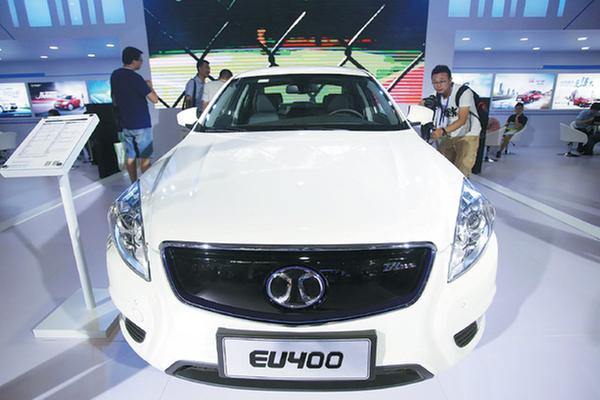Rural areas to boost new energy sales

 |
| An electric vehicle by BAIC Group catches visitors' eyes at an international new energy auto expo in Beijing. [Photo by CHEN XIAOGEN/CHINA DAILY] |
Shorter trips, better power access means low-tier markets have higher appetite for sector, Hao Yan reports.
After a market wobble in 2016, new energy vehicle sales are predicted to ramp up by 51.8 percent this year in China.
The Blue Book of New Energy Vehicles released earlier this month estimates that the annual sales volume for such cars will hit 700,000 vehicles in China.
The majority of the newly registered electric vehicles will be sold to lower-tier markets in towns and counties, and the markets in the largest and middle-sized cities will likely contribute smaller portions, according to the document.
"The sales volume of electrified vehicles in a broad sense could be bigger, as the authorities do not recognize mild hybrid cars as new energy vehicles," said John Zeng, managing director of LMC Automotive Consulting (Shanghai) Co.
"The official statistics count only those new energy vehicles that are eligible for the nation's subsidies."
The mild hybrid cars carrying 48-volt batteries, including Japan's Toyota and Lexus, and United States brands, are considered gasoline cars in the world's largest auto market.
The vehicles mainly consume petrol, despite demonstrating superior fuel efficiency.
The China Automotive Technology and Research Center estimated that the most popular electric car products would be those in the budget segments, and they would be more widely accepted in rural areas rather than in urban areas.
Similarly, Zeng said that pricing of lower-end products-below 100,000 yuan ($15,015) after the subsidies-would be more acceptable to the market.
Electric cars are usually only used for short-range driving, so customers are less interested in the longer range and therefore more expensive models, he explained.
"Those above 100,000 yuan, with bigger battery packs, will not be popular, because the subsidies given to the buyers are similar to those who bought the cheaper ones. Only a few buyers will pay 200,000 to 300,000 yuan for a car they are not confident enough to drive over a longer range," said Zeng.
"Besides, there are a large amount of low-speed mini-size electric cars, at about 30,000 yuan, mainly sold in rural areas.
They are usually used on countryside roads and are not included in national electric car statistics," Zeng added.
These low-speed mini-size electric cars, similar to enclosed golf carts, are usually manufactured by agricultural vehicle makers and distributed mainly to rural areas, especially the major agricultural provinces such as Shandong and Henan provinces.
Shandong provincial auto association announced in July that about 283,000 low-speed four-wheel electric cars were sold in the province in the first half this year.
However, these popular budget e-cars are not eligible for any type of subsidies.
Zhang Shulin, former secretary-general of China Association of Automotive Manufacturers, said the development of the new energy vehicle sector should not rely on subsidies.
"If the market relies on the subsidies, there won't be effective competition among automakers, and the industry won't develop in the fully competitive way," he said.
The new energy sector has established elevated innovation capability, according to Wu Zhixin, deputy director of the China Automotive Technology and Research Center.
Zeng at LMC shared his prediction that there will not be a big change in the market structure, as the current consumption pattern reflects that an electric car has no scrap value after years of use.
"The electric cars are worth nothing after running five to six years, no matter if it is a cheap one or a 300,000 yuan premium one. The reason lies in the major cost coming from the battery packs, which cost less and less in car manufacturing."
He noted that demographic changes will be minor, as people in the third and fourth-tier cities have easy access to power outlets in their yards, so they can buy a budget e-car for just several years of use.
Urban residents will still face the shortage of public charging facilities and, in some tier-one and two cities, car registration plates, according to Zeng.




































